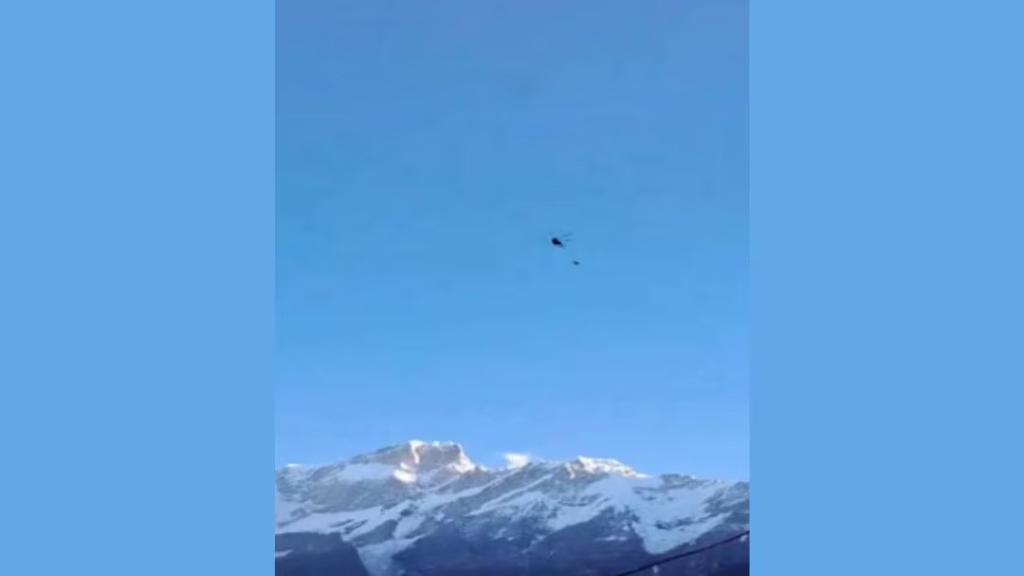Introduction: A Tense Incident in the Himalayas
On the morning of August 31, 2024, a private helicopter being airlifted from Uttarakhand’s Kedarnath to Gauchar by an Indian Air Force MI-17 helicopter crashed near the Mandakini River in Lincholi. This dramatic incident, caught on camera, has drawn significant attention due to the high-risk nature of aviation operations in the challenging Himalayan terrain. Thankfully, no injuries were reported, but the incident underscores the complexities and hazards associated with aerial transportation in such environments.

Technical Failures and Emergency Protocols
The private helicopter involved in the crash had previously encountered technical faults, leading to an emergency landing at Kedarnath’s helipad in May 2024. The helicopter was being transported to Gauchar airstrip for necessary repairs when the incident occurred. Rudraprayag District Tourism Officer Rahul Chaubey detailed the situation, noting that the MI-17 began losing balance due to the combined weight of the helicopter and strong winds.
Chaubey elaborated, “The MI-17, after covering a short distance, started to lose stability due to the additional weight of the private helicopter and the adverse wind conditions. The pilot had no option but to drop the helicopter near the Tharu camp to avoid further complications.” The MI-17 managed to land safely, and the situation was promptly addressed by rescue teams.
Adverse Weather Conditions Impacting Rescue Operations
The crash took place amid severe weather conditions that have significantly affected travel to Kedarnath. The region has been experiencing heavy rains and landslides, which have disrupted the trek route from Gaurikund to Kedarnath. The damage has led to a substantial decrease in pilgrimage traffic, with thousands of pilgrims stranded and requiring rescue operations.
Heavy rain and landslides along the route have rendered the trek route nearly impassable. Consequently, the Indian Air Force has been heavily involved in rescue missions, using Chinook and MI-17 helicopters, along with private choppers, to transport stranded individuals and provide necessary aid. This operation highlights the challenges faced in maintaining safety and providing timely assistance in the face of natural disasters.
Detailed Timeline of the Helicopter Incident
May 2024: The private helicopter, utilized for ferrying passengers to Kedarnath temple, experiences technical failures and makes an emergency landing at Kedarnath helipad. This incident results in the helicopter being out of commission and in need of repairs.
August 26, 2024: The Indian Air Force MI-17 is tasked with airlifting the defective helicopter from Kedarnath to Gauchar for repairs. The operation is crucial due to the helicopter’s importance in ferrying passengers to the temple.
August 31, 2024: During the airlift, the MI-17 encounters balance issues due to the helicopter’s weight and adverse wind conditions. The pilot is compelled to drop the helicopter near the Tharu camp to prevent a more dangerous situation. The crash is captured on camera, drawing attention to the ongoing challenges in the region.
Current Situation and Response Efforts
In the aftermath of the crash, rescue teams promptly arrived at the scene. The helicopter was found unoccupied, with no passengers or cargo onboard. Despite the lack of injuries, the incident has emphasized the importance of effective crisis management and safety protocols in such high-risk environments.
The ongoing weather conditions have compounded the difficulties faced by rescue teams, who are working tirelessly to manage the situation and support those affected by the adverse weather. The Air Force continues to play a vital role in the rescue and relief operations, highlighting the critical importance of aviation in disaster management.
Expert Opinions on the Incident
Experts have provided valuable insights into the incident, emphasizing the technical and environmental challenges of aviation in the Himalayas. Dr. Rajiv Kumar, an aviation safety expert, commented, “Operating helicopters in the Himalayan region requires meticulous planning and real-time adjustments due to unpredictable weather conditions. This incident highlights the need for rigorous safety checks and precise load management.”
Aviation analyst Meera Patel added, “The integrity of helicopters, especially when transporting additional weight, is crucial. The MI-17’s prompt response in dropping the defective helicopter minimized potential casualties and demonstrated the professionalism of the Indian Air Force’s crew.”
Conclusion: Lessons and Future Directions
The crash of the private helicopter near Kedarnath, while alarming, serves as a reminder of the inherent risks associated with aviation in extreme weather conditions. The quick actions of the MI-17 crew and the ongoing rescue efforts underscore the importance of safety and preparedness in managing emergencies in challenging environments.
For Regular News and Updates Follow – Sentinel eGazette
FAQs
1. What are the potential impacts of the helicopter crash on future rescue operations in Kedarnath?
The helicopter crash may lead to increased scrutiny of rescue operation protocols, particularly concerning load management and weather conditions. Future operations might incorporate additional safety measures and equipment checks to prevent similar incidents.
2. How has the recent heavy rainfall affected infrastructure in Kedarnath?
The heavy rainfall has severely damaged infrastructure, causing landslides and making trekking routes to Kedarnath impassable. This has led to disruptions in pilgrimages and necessitated enhanced rescue efforts to support stranded individuals.
3. What role did the Indian Air Force play in the aftermath of the helicopter crash?
The Indian Air Force played a critical role in the aftermath, deploying MI-17 and Chinook helicopters to assist with rescue operations and transport stranded individuals. Their swift response was crucial in managing the emergency situation.
4. What measures are being taken to repair and maintain helicopters used in high-risk areas like Kedarnath?
Maintenance procedures include rigorous pre-flight inspections, regular technical audits, and enhancements to adapt to the challenging Himalayan environment. Helicopters are subjected to stringent safety checks to ensure reliability during operations.
5. How can pilgrims ensure their safety when traveling to Kedarnath during adverse weather conditions?
Pilgrims should monitor weather forecasts, opt for reliable transportation providers, and consider alternative travel arrangements if conditions are severe. Adhering to safety guidelines and traveling with experienced operators can enhance safety during adverse weather.